生理学基本概念的中英文名词解释
- 格式:doc
- 大小:101.00 KB
- 文档页数:9
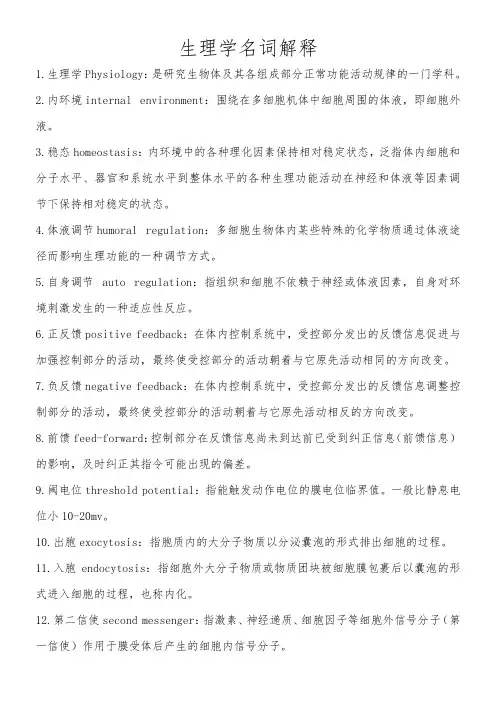
生理学名词解释1.生理学Physiology:是研究生物体及其各组成部分正常功能活动规律的一门学科。
2.内环境internalenvironment:围绕在多细胞机体中细胞周围的体液,即细胞外液。
3.稳态homeostasis:内环境中的各种理化因素保持相对稳定状态,泛指体内细胞和分子水平、器官和系统水平到整体水平的各种生理功能活动在神经和体液等因素调节下保持相对稳定的状态。
4.体液调节humoralregulation:多细胞生物体内某些特殊的化学物质通过体液途径而影响生理功能的一种调节方式。
5.自身调节 auto regulation:指组织和细胞不依赖于神经或体液因素,自身对环境刺激发生的一种适应性反应。
6.正反馈positivefeedback:在体内控制系统中,受控部分发出的反馈信息促进与加强控制部分的活动,最终使受控部分的活动朝着与它原先活动相同的方向改变。
7.负反馈negativefeedback:在体内控制系统中,受控部分发出的反馈信息调整控制部分的活动,最终使受控部分的活动朝着与它原先活动相反的方向改变。
8.前馈feed-forward:控制部分在反馈信息尚未到达前已受到纠正信息(前馈信息)的影响,及时纠正其指令可能出现的偏差。
9.阈电位thresholdpotential:指能触发动作电位的膜电位临界值。
一般比静息电位小10-20mv。
10.出胞exocytosis:指胞质内的大分子物质以分泌囊泡的形式排出细胞的过程。
11.入胞endocytosis:指细胞外大分子物质或物质团块被细胞膜包裹后以囊泡的形式进入细胞的过程,也称内化。
12.第二信使secondmessenger:指激素、神经递质、细胞因子等细胞外信号分子(第一信使)作用于膜受体后产生的细胞内信号分子。
13.兴奋性excitability:指机体的组织或细胞接受刺激后发生反应的能力或特性,它是生命活动的基本特征之一。
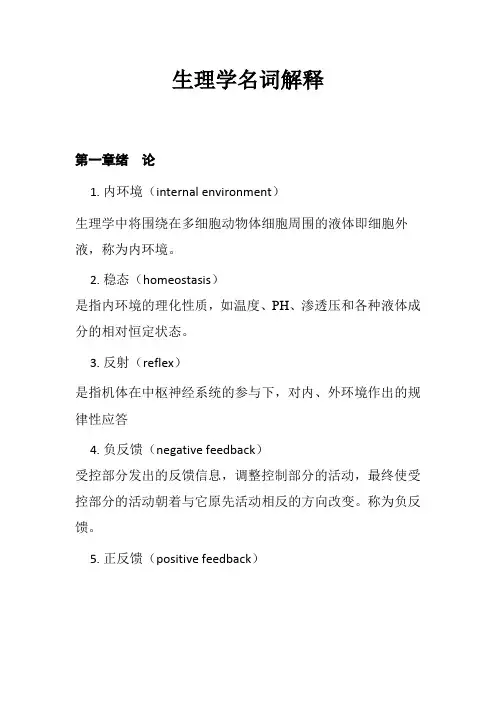
生理学名词解释第一章绪论1. 内环境(internal environment)生理学中将围绕在多细胞动物体细胞周围的液体即细胞外液,称为内环境。
2. 稳态(homeostasis)是指内环境的理化性质,如温度、PH、渗透压和各种液体成分的相对恒定状态。
3. 反射(reflex)是指机体在中枢神经系统的参与下,对内、外环境作出的规律性应答4. 负反馈(negative feedback)受控部分发出的反馈信息,调整控制部分的活动,最终使受控部分的活动朝着与它原先活动相反的方向改变。
称为负反馈。
5. 正反馈(positive feedback)受控部分发出的反馈信息,促进加强控制部分的活动,最后使受控部分的活动朝着与它原先活动相同的方向改变,称为正反馈。
6. 自身调节(autoregulation)是指组织细胞不依赖于神经或体液因素,自身对环境刺激发生的一种适应性反应。
7. 神经调节(nervous regulation)是通过反射而影响生理功能的一种调节方式,是人体生理功能中最主要的一种调节方式。
8. 体液调节(humoralregulation)是指体内某些特殊的化学物质通过体液途径而影响生理功能的一种方式。
第二章细胞的基本功能1. 单纯扩散(simple diffusion)即简单扩散,物质从质膜的高浓度一侧通过脂质分子间隙向低浓度一侧进行地跨膜运输,无生物学机制参与,无需耗能。
2. 易化扩散(facilitated diffusion)非脂溶性的小分子物质或带电离子在跨膜蛋白帮助下,顺浓度梯度和电位梯度进行地跨膜转运,属于被动转运,无需耗能3. 主动转运(active transport)某些物质在膜蛋白的帮助下,由细胞代谢提供能量而进行地逆浓度梯度和点位梯度的跨膜转运,根据是否直接耗能,可分为原发性主动转运和继发性主动转运4. 继发性主动转运(secondary active transport)某些物质的主动转运所需的驱动力并不直接来自ATP的分解,而是利用原发性主动转运机制建立起来的Na+或H+浓度梯度,在Na+或H+顺浓度梯度扩散的同时,使其他物质逆浓度梯度和电位梯度跨膜转运5. 钠泵(sodium pump)钠泵是镶嵌在细胞膜磷脂双份子层之间的一种特殊蛋白质,它是一种大分子蛋白,具有ATP酶的活性,当细胞内Na+增加或细胞膜外K+增加时被激活,因此又称Na-K依赖式ATP酶6. 静息电位(resting potential,RP)静息时,质膜两侧存在着外正内负的电位差,称为静息电位。
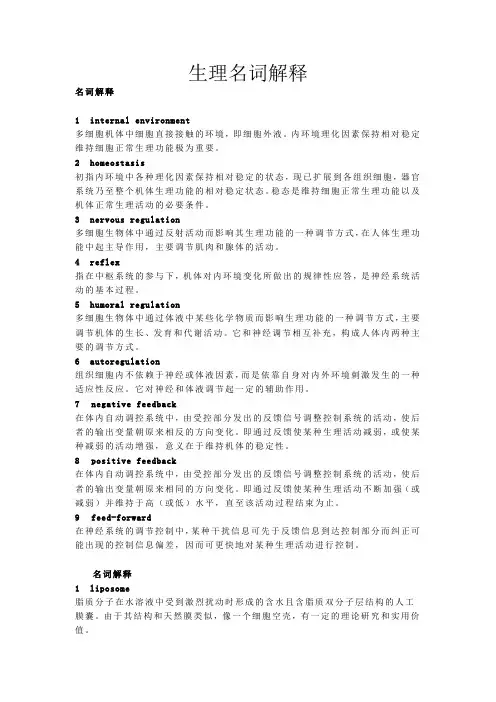
生理名词解释名词解释1internal environment多细胞机体中细胞直接接触的环境,即细胞外液。
内环境理化因素保持相对稳定维持细胞正常生理功能极为重要。
2homeostasis初指内环境中各种理化因素保持相对稳定的状态,现已扩展到各组织细胞,器官系统乃至整个机体生理功能的相对稳定状态。
稳态是维持细胞正常生理功能以及机体正常生理活动的必要条件。
3nervous regulation多细胞生物体中通过反射活动而影响其生理功能的一种调节方式,在人体生理功能中起主导作用,主要调节肌肉和腺体的活动。
4reflex指在中枢系统的参与下,机体对内环境变化所做出的规律性应答,是神经系统活动的基本过程。
5humoral regulation多细胞生物体中通过体液中某些化学物质而影响生理功能的一种调节方式,主要调节机体的生长、发育和代谢活动。
它和神经调节相互补充,构成人体内两种主要的调节方式。
6autoregulation组织细胞内不依赖于神经或体液因素,而是依靠自身对内外环境刺激发生的一种适应性反应。
它对神经和体液调节起一定的辅助作用。
7 negative feedback在体内自动调控系统中,由受控部分发出的反馈信号调整控制系统的活动,使后者的输出变量朝原来相反的方向变化。
即通过反馈使某种生理活动减弱,或使某种减弱的活动增强,意义在于维持机体的稳定性。
8 positive feedback在体内自动调控系统中,由受控部分发出的反馈信号调整控制系统的活动,使后者的输出变量朝原来相同的方向变化。
即通过反馈使某种生理活动不断加强(或减弱)并维持于高(或低)水平,直至该活动过程结束为止。
9 feed-forward在神经系统的调节控制中,某种干扰信息可先于反馈信息到达控制部分而纠正可能出现的控制信息偏差,因而可更快地对某种生理活动进行控制。
名词解释1liposome脂质分子在水溶液中受到激烈扰动时形成的含水且含脂质双分子层结构的人工膜囊。
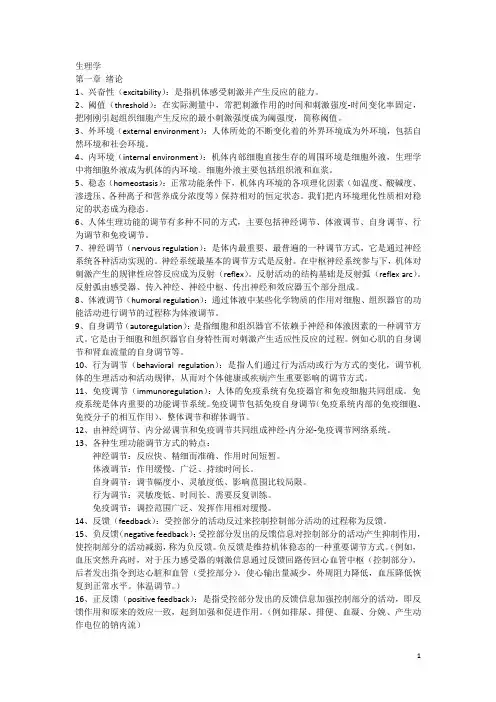
生理学第一章绪论1、兴奋性(excitability):是指机体感受刺激并产生反应的能力。
2、阈值(threshold):在实际测量中,常把刺激作用的时间和刺激强度-时间变化率固定,把刚刚引起组织细胞产生反应的最小刺激强度成为阈强度,简称阈值。
3、外环境(external environment):人体所处的不断变化着的外界环境成为外环境,包括自然环境和社会环境。
4、内环境(internal environment):机体内部细胞直接生存的周围环境是细胞外液,生理学中将细胞外液成为机体的内环境。
细胞外液主要包括组织液和血浆。
5、稳态(homeostasis):正常功能条件下,机体内环境的各项理化因素(如温度、酸碱度、渗透压、各种离子和营养成分浓度等)保持相对的恒定状态。
我们把内环境理化性质相对稳定的状态成为稳态。
6、人体生理功能的调节有多种不同的方式,主要包括神经调节、体液调节、自身调节、行为调节和免疫调节。
7、神经调节(nervous regulation):是体内最重要、最普遍的一种调节方式,它是通过神经系统各种活动实现的。
神经系统最基本的调节方式是反射。
在中枢神经系统参与下,机体对刺激产生的规律性应答反应成为反射(reflex)。
反射活动的结构基础是反射弧(reflex arc)。
反射弧由感受器、传入神经、神经中枢、传出神经和效应器五个部分组成。
8、体液调节(humoral regulation):通过体液中某些化学物质的作用对细胞、组织器官的功能活动进行调节的过程称为体液调节。
9、自身调节(autoregulation):是指细胞和组织器官不依赖于神经和体液因素的一种调节方式。
它是由于细胞和组织器官自身特性而对刺激产生适应性反应的过程。
例如心肌的自身调节和肾血流量的自身调节等。
10、行为调节(behavioral regulation):是指人们通过行为活动或行为方式的变化,调节机体的生理活动和活动规律,从而对个体健康或疾病产生重要影响的调节方式。
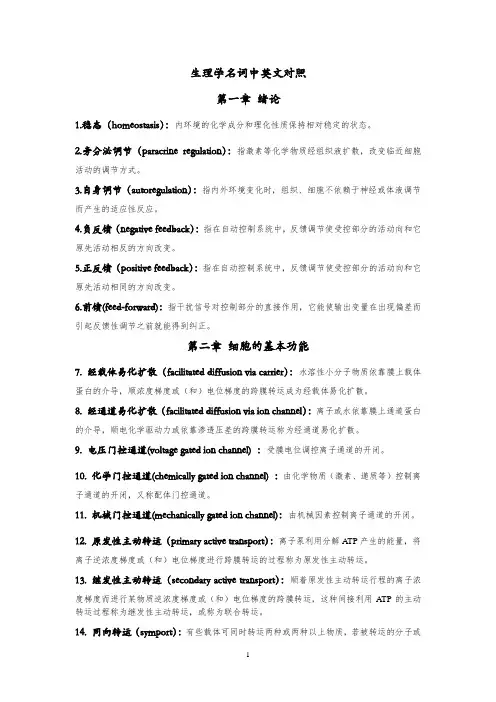
生理学名词中英文对照第一章绪论1.稳态(homeostasis):内环境的化学成分和理化性质保持相对稳定的状态。
2.旁分泌调节(paracrine regulation):指激素等化学物质经组织液扩散,改变临近细胞活动的调节方式。
3.自身调节(autoregulation):指内外环境变化时,组织、细胞不依赖于神经或体液调节而产生的适应性反应。
4.负反馈(negative feedback):指在自动控制系统中,反馈调节使受控部分的活动向和它原先活动相反的方向改变。
5.正反馈(positive feedback):指在自动控制系统中,反馈调节使受控部分的活动向和它原先活动相同的方向改变。
6.前馈(feed-forward):指干扰信号对控制部分的直接作用,它能使输出变量在出现偏差而引起反馈性调节之前就能得到纠正。
第二章细胞的基本功能7. 经载体易化扩散(facilitated diffusion via carrier):水溶性小分子物质依靠膜上载体蛋白的介导,顺浓度梯度或(和)电位梯度的跨膜转运成为经载体易化扩散。
8. 经通道易化扩散(facilitated diffusion via ion channel):离子或水依靠膜上通道蛋白的介导,顺电化学驱动力或依靠渗透压差的跨膜转运称为经通道易化扩散。
9. 电压门控通道(voltage gated ion channel) :受膜电位调控离子通道的开闭。
10. 化学门控通道(chemically gated ion channel) :由化学物质(激素、递质等)控制离子通道的开闭,又称配体门控通道。
11. 机械门控通道(mechanically gated ion channel):由机械因素控制离子通道的开闭。
12. 原发性主动转运(primary active transport):离子泵利用分解ATP产生的能量,将离子逆浓度梯度或(和)电位梯度进行跨膜转运的过程称为原发性主动转运。
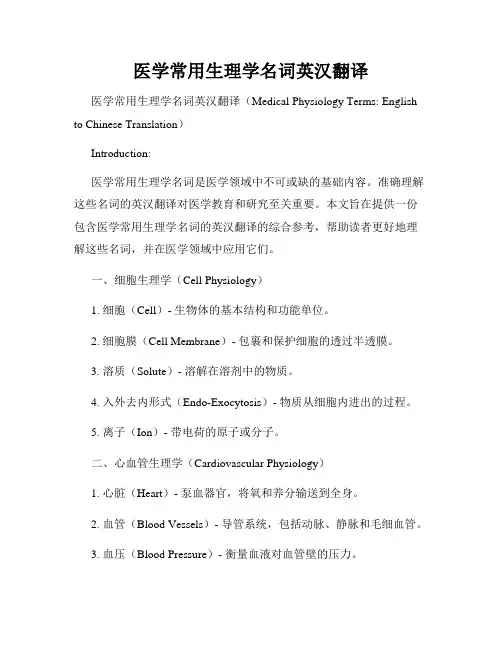
医学常用生理学名词英汉翻译医学常用生理学名词英汉翻译(Medical Physiology Terms: English to Chinese Translation)Introduction:医学常用生理学名词是医学领域中不可或缺的基础内容。
准确理解这些名词的英汉翻译对医学教育和研究至关重要。
本文旨在提供一份包含医学常用生理学名词的英汉翻译的综合参考,帮助读者更好地理解这些名词,并在医学领域中应用它们。
一、细胞生理学(Cell Physiology)1. 细胞(Cell)- 生物体的基本结构和功能单位。
2. 细胞膜(Cell Membrane)- 包裹和保护细胞的透过半透膜。
3. 溶质(Solute)- 溶解在溶剂中的物质。
4. 入外去内形式(Endo-Exocytosis)- 物质从细胞内进出的过程。
5. 离子(Ion)- 带电荷的原子或分子。
二、心血管生理学(Cardiovascular Physiology)1. 心脏(Heart)- 泵血器官,将氧和养分输送到全身。
2. 血管(Blood Vessels)- 导管系统,包括动脉、静脉和毛细血管。
3. 血压(Blood Pressure)- 衡量血液对血管壁的压力。
4. 心肌收缩(Myocardial Contraction)- 心肌收缩将血液推向体循环。
5. 心输出量(Cardiac Output)- 心脏每分钟泵出的血液量。
三、消化生理学(Digestive Physiology)1. 消化系统(Digestive System)- 约束口腔、食管、胃和肠道的器官组织。
2. 蛋白酶(Protease)- 分解蛋白质的酶。
3. 胆囊(Gallbladder)- 存储胆汁的器官。
4. 葡萄糖(Glucose)- 最常见的糖类,是能量的重要来源。
5. 肠道吸收(Intestinal Absorption)- 营养物质从肠道进入血液。
四、泌尿生理学(Renal Physiology)1. 肾脏(Kidneys)- 过滤血液,产生尿液,并维持体液平衡。
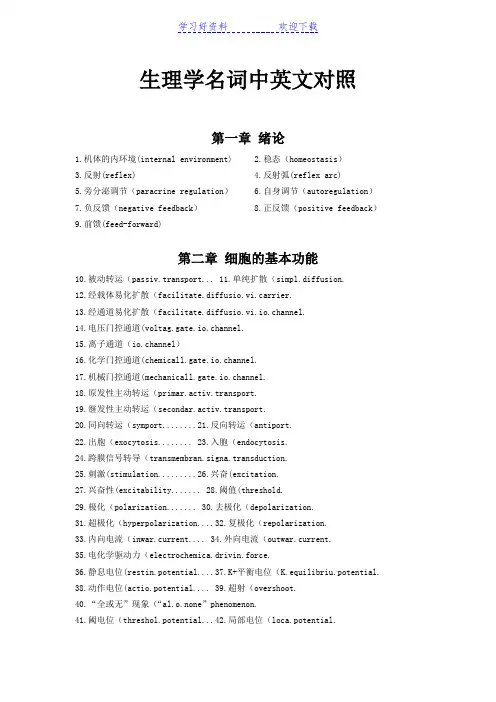
生理学名词中英文对照第一章绪论1.机体的内环境(internal environment)2.稳态(homeostasis)3.反射(reflex)4.反射弧(reflex arc)5.旁分泌调节(paracrine regulation)6.自身调节(autoregulation)7.负反馈(negative feedback)8.正反馈(positive feedback)9.前馈(feed-forward)第二章细胞的基本功能10.被动转运(passiv.transport... 11.单纯扩散(simpl.diffusion.12.经载体易化扩散(facilitate.diffusio.vi.carrier.13.经通道易化扩散(facilitate.diffusio.vi.io.channel.14.电压门控通道(voltag.gate.io.channel.15.离子通道(io.channel)16.化学门控通道(chemicall.gate.io.channel.17.机械门控通道(mechanicall.gate.io.channel.18.原发性主动转运(primar.activ.transport.19.继发性主动转运(secondar.activ.transport.20.同向转运(symport........21.反向转运(antiport.22.出胞(exocytosis........ 23.入胞(endocytosis.24.跨膜信号转导(transmembran.signa.transduction.25.刺激(stimulation.........26.兴奋(excitation.27.兴奋性(excitability....... 28.阈值(threshold.29.极化(polarization....... 30.去极化(depolarization.31.超极化(hyperpolarization....32.复极化(repolarization.33.内向电流(inwar.current.... 34.外向电流(outwar.current.35.电化学驱动力(electrochemica.drivin.force.36.静息电位(restin.potential....37.K+平衡电位(K.equilibriu.potential.38.动作电位(actio.potential.... 39.超射(overshoot.40.“全或无”现象(“al.o.none”phenomenon.41.阈电位(threshol.potential...42.局部电位(loca.potential.43.时间性总和(tempora.summation. 44.空间性总和(spatia.summation.45.量子释放(quanta.release.46.兴奋-收缩耦联(excitation-contractio.coupling.47.等长收缩(isometri.contraction.48.等张收缩(isotoni.contraction.49.前负荷(preload.........50.后负荷(afterload.51. 肌肉收缩能力(contractility) 52. 不完全强直收缩(incomplete tetauns)53. 完全强直收缩(complete tetanus) 54.运动单位(motor unit)第三章血液55.血细胞比容(hematocrit......56.血浆渗透压(plasm.osmoti.pressure.57.血浆晶体渗透压(plasm.crysta.osmoti.pressure.58.血浆胶体渗透压(plasm.colloi.osmoti.pressure.59.悬浮稳定性(suspensio.stability.60.红细胞沉降率(erythrocyte sedimentation rate)61.红细胞渗透脆性(osmotic fragility) 62.血小板黏附(platelet adhesion)63.血小板聚集(platelet aggregation) 64.生理性止血(hemostasis)65.出血时间(bleeding time) 66.凝血时间(clotting time)67.血液凝固(blood coagulation) 68.血清(serum)69.凝血因子(clotting factor) 70.内源性凝血途径(intrinsic pathway)71.外源性凝血途径(extrinsic pathway) 72.纤维蛋白溶解(fibrinolysis)73.血型(blood group) 74.红细胞凝集(agglutination)75.凝集原(agglutinogen)76.凝集素(agglutinin)77.交叉配血试验(corss-match test)第四章血液循环78.心动周期(cardia.cycle.79.等容收缩期(perio.o.isovolumi.contraction)80.等容舒张期(perio.o.isovolumi.relaxation)81.每搏输出量(strok.volume... 82.射血分数(ejectio.fraction)83.心输出量(cardia.output... 8.心指数(cardia.index)85.异长调节(heterometri.regulation.86.心室功能曲线(ventricular function curve)87.心肌收缩能力(myocardial contractility)88.等长调节(homometric regulation)89.快反应细胞(fast response cell) 90.慢反应细胞(slow response cell)91.期前收缩(premature systole) 92.代偿间歇(compensatory pause)93.自动节律性(autorhythmicity) 94.正常起搏点(normal pacemaker)95.潜在起搏点(latent pacemaker) 96.异位起搏点(ectopic pacemaker)97.房室延搁(atrioventricular delay)98.膜反应曲线(membrane responsiveness curve)99.钙触发钙释放(calcium-induced Ca2+ release)100.外周阻力(peripheral resistance)101.动脉血压(arterial blood pressure)102.收缩压(systolic pressure)103.舒张压(diastolic pressure) 104.平均动脉压(mean arterial pressure)105.中心静脉压(central venous pressure)106.微循环(microcirculation) 107.压力感受性反射(baroreceptor reflex)第五章呼吸108.肺通气(pulmonary ventilation) 109.肺换气(gas exchange in lungs)110.呼吸运动(respiratory movement) 111.弹性阻力(elastic resistance)112.顺应性(compliance) 113.肺的静态顺应性(static compliance)114.比顺应性(specific compliance) 115.肺表面活性物质(pulmonary surfactant)116.气道阻力(airway resistance) 117.潮气量(tidal volume)118.余气量(residual volume)119.功能余气量(functional residual capacity)120.肺活量(vital capacity) 121.用力肺活量(forced vital capacity) 122.用力呼气量(forced expiratory volume)123.肺通气量(pulmonary ventilation)124.解剖无效腔(anatomical dead space) 125.肺泡无效腔(alveolar dead space) 126.肺泡通气量(alveolar ventilation)127.通气/血流比值(ventilation/perfusion ratio)128.血氧容量(oxygen capacity) 129.血氧含量(oxygen content)130.血氧饱和度(oxygen saturation) 131.氧解离曲线(oxygen dissociation curve) 132.肺牵张反射(pulmonary stretch reflex)第六章消化与吸收133.消化(digestion) 134.机械性消化(mechanical digestion)135.化学性消化(chemical digestion) 136.吸收(absorption)137.慢波(slow wave) 138.胃肠激素(gastrointestinal hormone)139.脑-肠肽(braingut peptide)140.黏液-碳酸氢盐屏障(mucus bicarbonate barrier)141.胃黏膜屏障(gastric mucosal barrier)142.容受性舒张(receptive relaxation)143.紧张性收缩(tonic contraction) 144.胃的排空(gastric emptying)145.肠-胃反射(entero-gastric reflex) 146.分节运动(segmentation contraction)147.胆盐的肠-肝循环(enterohepatic circulation of bile salt)第七章能量代谢与体温148.能量代谢(energ.metabolism).149.食物的热价(therma.equivalen.o.food)150.氧热价(therma.equivalen.o.oxygen)151.呼吸商(respirator.quotient) 152.基础代谢率(basa.metaboli.rate)153.体温(bod.temperature)... 154.温热性发汗(therma.sweating)155.精神性发汗(mental sweating 156.热敏神经元(warm-sensitive neuron) 157.冷敏神经元(cold-sensitive neuron)第八章尿的生成和排出158.管-球反馈(tubuloglomerula.feedback)159.肾小球滤过率(glomerula.filtratio.rate)160.滤过分数(filtratio.fraction)161.有效滤过压(effectiv.filtratio.pressure)162.肾糖阈(rena.threshol.fo.glucose)163.葡萄糖吸收极限量(transfe.maximu.o.glucose)164.渗透性利尿(osmoti.diuresis)165.球-管平衡(glomerulotubula.balance) 166.水利尿(wate.diuresis)... 167.清除率(clearance)第九章感觉器官的功能168.感受器(receptor.......... 169.感觉器官(an)170.适宜刺激(adequat.stimulus)...171.换能作用(transduce.function..172.瞳孔对光反射(pupillar.ligh.reflex)173.互感性对光反射(consensual light reflex)174.瞳孔近反射(nea.refle.o.th.pupil)175.视敏度(visua.acuity)176.暗适应(dark adaptation) 177.明适应(light adaptation)178.视野(visual field) 179.听阈(hearing threshold)180.耳蜗内电位(endocochlear potential)181.耳蜗微音器电位(cochlear microphonic potential)182.眼球震颤(nystagmus)第十章神经系统的功能183.突触(synapse) 184.经典的突触(classical synapse)185.兴奋性突触后电位(excitatory postsynaptic potential)186.抑制性突触后电位(inhibitory postsynaptic potential)187.非定向突触(non-directed synapse) 188.电突触(electric synapse)189.神经递质(neurotransmitter) 190.神经调质(neuromodulator)191.受体(receptor) 192.激动剂(agonist)193.拮抗剂(antagonist) 194.上调(up regulation)195.下调(down regulation) 196.胆碱能纤维(cholinergic fiber)197.肾上腺素能纤维(adrenergic fiber) 198.突触后抑制(postsynaptic inhibition)199.传入侧支性抑制(afferent collateral inhibition)200.回返性抑制(recurrent inhibition) 201.突触前抑制(presynaptic inhibition)202.特异投射系统(specific projection system)203.非特异投射系统(nonspecific projection system)204.牵涉痛(referred pain) 205.脊休克(spinal shock)206.牵张反射(stretch reflex) 207.腱反射(tendon reflex)208.肌紧张(muscle tonus) 209.去大脑僵直(decerebrate rigidity)210.α僵直(α-rigidity) 211.γ僵直(γ-rigidity)212.自发脑电活动(spontaneous electric activity of the brain)213.脑电图(electroencephalogram)214.脑干网状结构上行激动系统(ascending reticular activating system) 215.慢波睡眠(slow wave sleep) 216.异相睡眠(paradoxical sleep)第十一章内分泌217.激素(hormone) .........218.允许作用(permissiv.action)219.长反馈(long-loo.feedback). 220.短反馈(short-loo.feedback)221.超短反馈(ultra-short-loo.feedback)222.下丘脑调节肽(hypothalami.regulator.peptides)223.应激反应(stres.reaction)..224.应急反应(emergenc.reaction)第十二章生殖225.月经(menstruation....... 226.月经周期(menstrua.cycle..227.增生期(proliferativ.phase...228.黄体期(lutea.phase.。
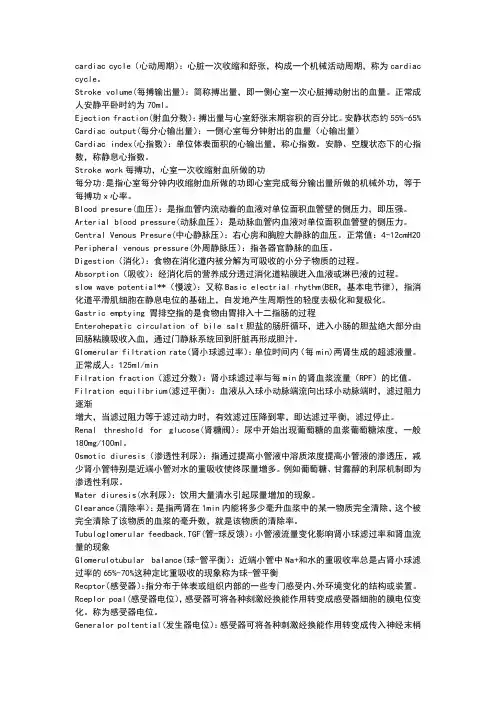
cardiac cycle(心动周期):心脏一次收缩和舒张,构成一个机械活动周期,称为cardiac cycle。
Stroke volume(每搏输出量):简称搏出量,即一侧心室一次心脏搏动射出的血量。
正常成人安静平卧时约为70ml。
Ejection fraction(射血分数):搏出量与心室舒张末期容积的百分比。
安静状态约55%-65% Cardiac output(每分心输出量):一侧心室每分钟射出的血量(心输出量)Cardiac index(心指数):单位体表面积的心输出量,称心指数。
安静、空腹状态下的心指数,称静息心指数。
Stroke work每搏功,心室一次收缩射血所做的功每分功:是指心室每分钟内收缩射血所做的功即心室完成每分输出量所做的机械外功,等于每搏功x心率。
Blood presure(血压):是指血管内流动着的血液对单位面积血管壁的侧压力,即压强。
Arterial blood pressure(动脉血压):是动脉血管内血液对单位面积血管壁的侧压力。
Central Venous Presure(中心静脉压):右心房和胸腔大静脉的血压。
正常值:4-12cmH20 Peripheral venous pressure(外周静脉压):指各器官静脉的血压。
Digestion(消化):食物在消化道内被分解为可吸收的小分子物质的过程。
Absorption(吸收):经消化后的营养成分透过消化道粘膜进入血液或淋巴液的过程。
slow wave potential**(慢波):又称Basic electrial rhythm(BER,基本电节律),指消化道平滑肌细胞在静息电位的基础上,自发地产生周期性的轻度去极化和复极化。
Gastric emptying 胃排空指的是食物由胃排入十二指肠的过程Enterohepatic circulation of bile salt胆盐的肠肝循环,进入小肠的胆盐绝大部分由回肠粘膜吸收入血,通过门静脉系统回到肝脏再形成胆汁。
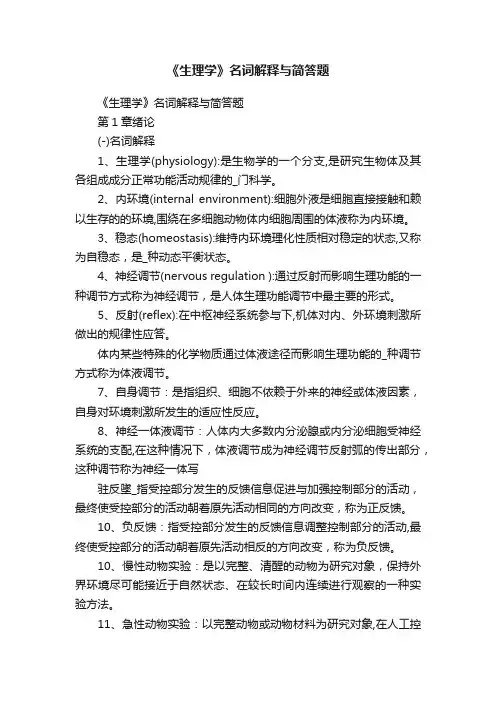
《生理学》名词解释与简答题《生理学》名词解释与简答题第1章绪论(-)名词解释1、生理学(physiology):是生物学的一个分支,是研究生物体及其各组成成分正常功能活动规律的_门科学。
2、内环境(internal environment):细胞外液是细胞直接接触和赖以生存的的环境,围绕在多细胞动物体内细胞周围的体液称为内环境。
3、稳态(homeostasis):维持内环境理化性质相对稳定的状态,又称为自稳态,是_种动态平衡状态。
4、神经调节(nervous regulation ):通过反射而影响生理功能的一种调节方式称为神经调节,是人体生理功能调节中最主要的形式。
5、反射(reflex):在中枢神经系统参与下,机体对内、外环境刺激所做出的规律性应答。
体内某些特殊的化学物质通过体液途径而影响生理功能的_种调节方式称为体液调节。
7、自身调节:是指组织、细胞不依赖于外来的神经或体液因素,自身对环境刺激所发生的适应性反应。
8、神经一体液调节:人体内大多数内分泌腺或内分泌细胞受神经系统的支配,在这种情况下,体液调节成为神经调节反射弧的传出部分,这种调节称为神经一体写驻反墜_指受控部分发生的反馈信息促进与加强控制部分的活动,最终使受控部分的活动朝着原先活动相同的方向改变,称为正反馈。
10、负反馈:指受控部分发生的反馈信息调整控制部分的活动,最终使受控部分的活动朝着原先活动相反的方向改变,称为负反馈。
10、慢性动物实验:是以完整、清醒的动物为研究对象,保持外界环境尽可能接近于自然状态、在较长时间内连续进行观察的一种实验方法。
11、急性动物实验:以完整动物或动物材料为研究对象,在人工控制的实验环境条件下,在短时间内对动物某些生理活动进行记录和观察的实验。
12、条件反射:是后天获得的,是在一定条件下建立于非条件反射基础之上的反射,是一种高级的神经活动.13、非条件反射:是先天遗传的,为种族共有的,是一种初级的神经活动。
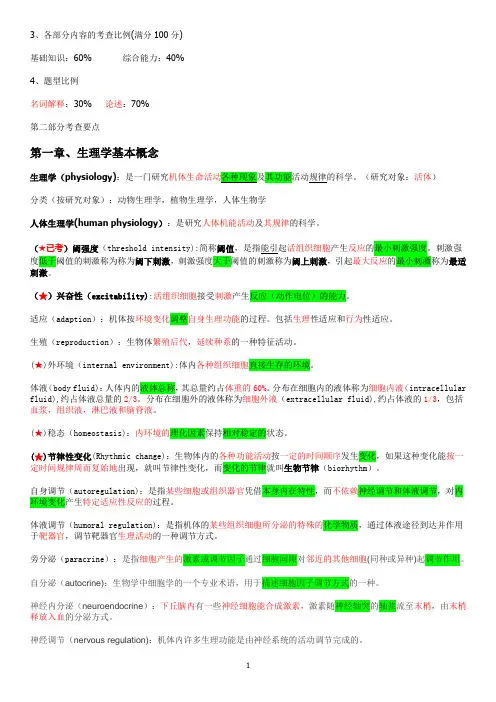
3、各部分内容的考查比例(满分100分)基础知识:60% 综合能力:40%4、题型比例名词解释:30% 论述:70%第二部分考查要点第一章、生理学基本概念生理学(physiology):是一门研究机体生命活动各种现象及其功能活动规律的科学。
(研究对象:活体)分类(按研究对象):动物生理学,植物生理学,人体生物学人体生理学(human physiology):是研究人体机能活动及其规律的科学。
(★已考)阈强度(threshold intensity):简称阈值,是指能引起活组织细胞产生反应的最小刺激强度。
刺激强度低于阈值的刺激称为称为阈下刺激,刺激强度大于阈值的刺激称为阈上刺激,引起最大反应的最小刺激称为最适刺激。
(★)兴奋性(excitability):活组织细胞接受刺激产生反应(动作电位)的能力。
适应(adaption):机体按环境变化调整自身生理功能的过程。
包括生理性适应和行为性适应。
生殖(reproduction):生物体繁殖后代,延续种系的一种特征活动。
(★)外环境(internal environment):体内各种组织细胞直接生存的环境。
体液(body fluid):人体内的液体总称,其总量约占体重的60%。
分布在细胞内的液体称为细胞内液(intracellular fluid),约占体液总量的2/3。
分布在细胞外的液体称为细胞外液(extracellular fluid),约占体液的1/3,包括血浆,组织液,淋巴液和脑脊液。
(★)稳态(homeostasis):内环境的理化因素保持相对稳定的状态。
(★)节律性变化(Rhythmic change):生物体内的各种功能活动按一定的时间顺序发生变化,如果这种变化能按一定时间规律周而复始地出现,就叫节律性变化,而变化的节律就叫生物节律(biorhythm)。
自身调节(autoregulation):是指某些细胞或组织器官凭借本身内在特性,而不依赖神经调节和体液调节,对内环境变化产生特定适应性反应的过程。
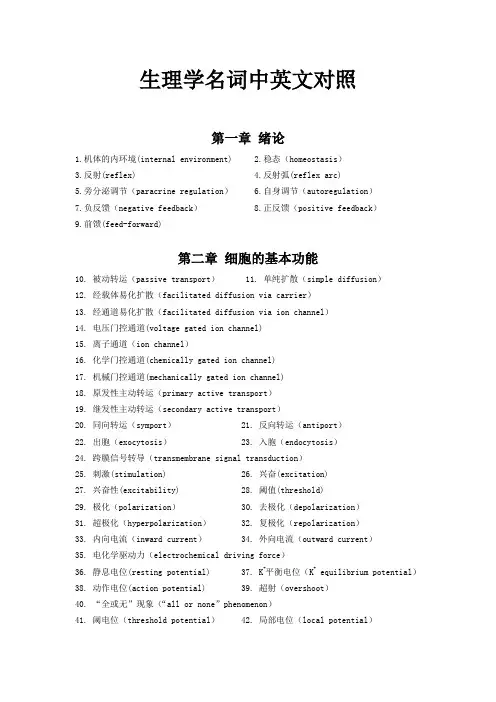
生理学名词中英文对照第一章绪论1.机体的内环境(internal environment)2.稳态(homeostasis)3.反射(reflex)4.反射弧(reflex arc)5.旁分泌调节(paracrine regulation)6.自身调节(autoregulation)7.负反馈(negative feedback) 8.正反馈(positive feedback)9.前馈(feed-forward)第二章细胞的基本功能10. 被动转运(passive transport) 11. 单纯扩散(simple diffusion)12. 经载体易化扩散(facilitated diffusion via carrier)13. 经通道易化扩散(facilitated diffusion via ion channel)14. 电压门控通道(voltage gated ion channel)15. 离子通道(ion channel)16. 化学门控通道(chemically gated ion channel)17. 机械门控通道(mechanically gated ion channel)18. 原发性主动转运(primary active transport)19. 继发性主动转运(secondary active transport)20. 同向转运(symport) 21. 反向转运(antiport)22. 出胞(exocytosis) 23. 入胞(endocytosis)24. 跨膜信号转导(transmembrane signal transduction)25. 刺激(stimulation) 26. 兴奋(excitation)27. 兴奋性(excitability) 28. 阈值(threshold)29. 极化(polarization) 30. 去极化(depolarization)31. 超极化(hyperpolarization) 32. 复极化(repolarization)33. 内向电流(inward current) 34. 外向电流(outward current)35. 电化学驱动力(electrochemical driving force)36. 静息电位(resting potential) 37. K+平衡电位(K+ equilibrium potential)38. 动作电位(action potential) 39. 超射(overshoot)40. “全或无”现象(“all or none”phenomenon)41. 阈电位(threshold potential) 42. 局部电位(local potential)43. 时间性总和(temporal summation) 44. 空间性总和(spatial summation)45. 量子释放(quantal release)46. 兴奋-收缩耦联(excitation-contraction coupling)47. 等长收缩(isometric contraction) 48. 等张收缩(isotonic contraction)49. 前负荷(preload) 50. 后负荷(afterload)51.肌肉收缩能力(contractility) 52.不完全强直收缩(incomplete tetauns)53.完全强直收缩(complete tetanus) 54.运动单位(motor unit)第三章血液55. 血细胞比容(hematocrit) 56. 血浆渗透压(plasma osmotic pressure)57. 血浆晶体渗透压(plasma crystal osmotic pressure)58. 血浆胶体渗透压(plasma colloid osmotic pressure)59. 悬浮稳定性(suspension stability)60.红细胞沉降率(erythrocyte sedimentation rate)61.红细胞渗透脆性(osmotic fragility) 62.血小板黏附(platelet adhesion)63.血小板聚集(platelet aggregation) 64.生理性止血(hemostasis)65.出血时间(bleeding time) 66.凝血时间(clotting time)67.血液凝固(blood coagulation) 68.血清(serum)69.凝血因子(clotting factor) 70.内源性凝血途径(intrinsic pathway)71.外源性凝血途径(extrinsic pathway) 72.纤维蛋白溶解(fibrinolysis)73.血型(blood group) 74.红细胞凝集(agglutination)75.凝集原(agglutinogen)76.凝集素(agglutinin)77.交叉配血试验(corss-match test)第四章血液循环78. 心动周期(cardiac cycle)79. 等容收缩期(period of isovolumic contraction)80. 等容舒张期(period of isovolumic relaxation)81. 每搏输出量(stroke volume)82. 射血分数(ejection fraction)83. 心输出量(cardiac output)84 心指数(cardiac index)85. 异长调节(heterometric regulation)86.心室功能曲线(ventricular function curve)87.心肌收缩能力(myocardial contractility)88.等长调节(homometric regulation)89.快反应细胞(fast response cell) 90.慢反应细胞(slow response cell)91.期前收缩(premature systole) 92.代偿间歇(compensatory pause)93.自动节律性(autorhythmicity) 94.正常起搏点(normal pacemaker)95.潜在起搏点(latent pacemaker) 96.异位起搏点(ectopic pacemaker)97.房室延搁(atrioventricular delay)98.膜反应曲线(membrane responsiveness curve)99.钙触发钙释放(calcium-induced Ca2+ release)100.外周阻力(peripheral resistance)101.动脉血压(arterial blood pressure)102.收缩压(systolic pressure)103.舒张压(diastolic pressure) 104.平均动脉压(mean arterial pressure)105.中心静脉压(central venous pressure)106.微循环(microcirculation) 107.压力感受性反射(baroreceptor reflex)第五章呼吸108.肺通气(pulmonary ventilation) 109.肺换气(gas exchange in lungs)110.呼吸运动(respiratory movement) 111.弹性阻力(elastic resistance)112.顺应性(compliance) 113.肺的静态顺应性(static compliance)114.比顺应性(specific compliance) 115.肺表面活性物质(pulmonary surfactant)116.气道阻力(airway resistance) 117.潮气量(tidal volume)118.余气量(residual volume)119.功能余气量(functional residual capacity)120.肺活量(vital capacity) 121.用力肺活量(forced vital capacity) 122.用力呼气量(forced expiratory volume)123.肺通气量(pulmonary ventilation)124.解剖无效腔(anatomical dead space) 125.肺泡无效腔(alveolar dead space) 126.肺泡通气量(alveolar ventilation)127.通气/血流比值(ventilation/perfusion ratio)128.血氧容量(oxygen capacity) 129.血氧含量(oxygen content)130.血氧饱和度(oxygen saturation) 131.氧解离曲线(oxygen dissociation curve) 132.肺牵张反射(pulmonary stretch reflex)第六章消化与吸收133.消化(digestion) 134.机械性消化(mechanical digestion)135.化学性消化(chemical digestion) 136.吸收(absorption)137.慢波(slow wave) 138.胃肠激素(gastrointestinal hormone)139.脑-肠肽(braingut peptide)140.黏液-碳酸氢盐屏障(mucus bicarbonate barrier)141.胃黏膜屏障(gastric mucosal barrier)142.容受性舒张(receptive relaxation)143.紧张性收缩(tonic contraction) 144.胃的排空(gastric emptying)145.肠-胃反射(entero-gastric reflex) 146.分节运动(segmentation contraction)147.胆盐的肠-肝循环(enterohepatic circulation of bile salt)第七章能量代谢与体温148. 能量代谢(energy metabolism)149. 食物的热价(thermal equivalent of food)150. 氧热价(thermal equivalent of oxygen)151. 呼吸商(respiratory quotient) 152. 基础代谢率(basal metabolic rate) 153. 体温(body temperature) 154.温热性发汗(thermal sweating)155.精神性发汗(mental sweating 156.热敏神经元(warm-sensitive neuron) 157.冷敏神经元(cold-sensitive neuron)第八章尿的生成和排出158. 管-球反馈(tubuloglomerular feedback)159. 肾小球滤过率(glomerular filtration rate)160. 滤过分数(filtration fraction)161. 有效滤过压(effective filtration pressure)162. 肾糖阈(renal threshold for glucose)163. 葡萄糖吸收极限量(transfer maximum of glucose)164. 渗透性利尿(osmotic diuresis)165. 球-管平衡(glomerulotubular balance) 166. 水利尿(water diuresis) 167.清除率(clearance)第九章感觉器官的功能168. 感受器(receptor) 169. 感觉器官(sense organ)170. 适宜刺激(adequate stimulus) 171. 换能作用(transducer function)172. 瞳孔对光反射(pupillary light reflex)173.互感性对光反射(consensual light reflex)174. 瞳孔近反射(near reflex of the pupil)175.视敏度(visual acuity)176.暗适应(dark adaptation) 177.明适应(light adaptation)178.视野(visual field) 179.听阈(hearing threshold)180.耳蜗内电位(endocochlear potential)181.耳蜗微音器电位(cochlear microphonic potential)182.眼球震颤(nystagmus)第十章神经系统的功能183.突触(synapse) 184.经典的突触(classical synapse)185.兴奋性突触后电位(excitatory postsynaptic potential)186.抑制性突触后电位(inhibitory postsynaptic potential)187.非定向突触(non-directed synapse) 188.电突触(electric synapse)189.神经递质(neurotransmitter) 190.神经调质(neuromodulator)191.受体(receptor) 192.激动剂(agonist)193.拮抗剂(antagonist) 194.上调(up regulation)195.下调(down regulation) 196.胆碱能纤维(cholinergic fiber)197.肾上腺素能纤维(adrenergic fiber) 198.突触后抑制(postsynaptic inhibition)199.传入侧支性抑制(afferent collateral inhibition)200.回返性抑制(recurrent inhibition) 201.突触前抑制(presynaptic inhibition)202.特异投射系统(specific projection system)203.非特异投射系统(nonspecific projection system)204.牵涉痛(referred pain) 205.脊休克(spinal shock)206.牵张反射(stretch reflex) 207.腱反射(tendon reflex)208.肌紧张(muscle tonus) 209.去大脑僵直(decerebrate rigidity)210.α僵直(α-rigidity) 211.γ僵直(γ-rigidity)212.自发脑电活动(spontaneous electric activity of the brain)213.脑电图(electroencephalogram)214.脑干网状结构上行激动系统(ascending reticular activating system) 215.慢波睡眠(slow wave sleep) 216.异相睡眠(paradoxical sleep)第十一章内分泌217. 激素(hormone) 218. 允许作用(permissive action) 219. 长反馈(long-loop feedback) 220. 短反馈(short-loop feedback)221. 超短反馈(ultra-short-loop feedback)222. 下丘脑调节肽(hypothalamic regulatory peptides)223. 应激反应(stress reaction) 224.应急反应(emergency reaction)第十二章生殖225. 月经(menstruation) 226. 月经周期(menstrual cycle)227. 增生期(proliferative phase) 228. 黄体期(luteal phase)。
生理名词解释生理学(Physiology):是生物科学的一个分支,是研究生物体及其各组成部分正常功能活动规律的一门科学。
内环境(internal environment):生理学中将围绕在多细胞动物体内细胞周围的体液,即细胞外液。
稳态(homeostasis):也称自稳态,是指内环境的理化性质,如温度,PH,渗透压和各种体液成分等的相对恒定状态。
体液调节(humoral regulation):是指体内某些特殊的化学物质通过体液途径而影响生理功能的一种调节方式。
自身调节(autoregulation):是指组织细胞不依赖于神经或体液因素,自身对环境刺激发生的一种适应性反应。
正反馈(positive feedback):受控部分发出的反馈信息促进与加强控制部分的活动,最终使受控部分的活动朝着与它原先活动相同的方向改变。
负反馈(negative feedback):受控部分发出的反馈信息调整控制部分的活动,最终使受控部分的活动朝着与它原先活动相反的方向改变。
前馈(feed-forward):控制部分在反馈信息尚未到达前已受到纠正信息(前馈信息)的影响,及时纠正其指令可能出现的偏差,这种自动控制形式称为前馈。
阈电位(threshold potential):细胞去极化达到刚刚引发动作电位的临界跨膜电位数值。
出胞(exocytosis):是指胞质内的大分子物质以分泌囊泡的形式排出细胞的过程。
入胞(endocytosis):是指大分子物质或物质团块借助于细胞形成吞噬泡或吞饮泡的方式进入细胞的过程。
第二信使(second messenger):是指激素,递质,细胞因子等信号分子作用于细胞膜后产生的细胞内信号分子。
兴奋性(excitability):生物学中将可兴奋细胞接受刺激后产生动作电位的能力称为细胞的兴奋性。
静息电位(resting potential):静息是质膜两侧存在着外正内负的电位差,称为静息电位。
生理学基础的名词解释生理学是研究生命现象的科学,它关注的是生物体的各种正常功能和生理过程。
它揭示了细胞、组织和器官在生命活动中的作用和相互关系。
在这篇文章中,我们将解释一些生理学基础的名词,让读者更好地了解人体的运作机制。
1. 细胞膜(Cell membrane)细胞膜是细胞表面的一层薄膜,由脂质和蛋白质组成。
它起到了选择性通透性的作用,控制物质的进出。
此外,细胞膜也与细胞间的相互作用和信号传导密切相关。
2. 细胞核(Cell nucleus)细胞核是细胞内的一个结构,通常位于细胞中心。
它含有遗传物质(DNA),编码了生物体的遗传信息。
细胞核还参与到基因的表达和调控中,控制着生物体的生长、发育和功能。
3. 肌肉(Muscle)肌肉是人体内最常见的组织之一,它能够通过收缩和放松以产生力量和运动。
肌肉可以分为骨骼肌、平滑肌和心肌。
骨骼肌负责骨骼运动,平滑肌存在于内脏器官中,而心肌则构成了心脏。
4. 神经元(Neuron)神经元是构成神经系统的基本单位,它由细胞体、树突、轴突和突触组成。
神经元能够传递电信号,参与到神经递质的释放和传导中。
通过神经元的相互连接和协调,我们才能够感受到周围环境并做出相应的反应。
5. 激素(Hormone)激素是由内分泌腺分泌的化学物质,它们以血液为媒介,影响着人体各个系统的活动和平衡。
激素控制着生长、代谢、情绪、生殖等多种生理过程。
典型的激素包括胰岛素、甲状腺素和雄激素。
6. 呼吸(Respiration)呼吸是人体获取氧气并排出二氧化碳的过程。
它可以分为外呼吸和内呼吸两个部分。
外呼吸指的是氧气从外界进入肺部,二氧化碳通过呼出排除体外;内呼吸则是氧气在肺泡和血液之间的气体交换。
7. 储能物质(Energy storage)储能物质是人体储备能量的形式,主要有脂肪和糖原。
脂肪是人体最重要的能量来源,它能够在需要时转化为葡萄糖提供能量。
糖原则是一种短期储备能量的形式,存在于肝脏和肌肉细胞中。
生理学的名词解释重点中英生理学是研究生命现象和功能的科学领域。
它涵盖了各种生物体内部的生物化学过程、细胞活动以及整个生物体的功能调节。
在生理学中,有许多重要的名词需要我们进行解释。
1. 细胞膜 (Cell Membrane)细胞膜是细胞的外皮,由双层磷脂分子、蛋白质和其他分子组成。
它起到了筛选物质进出细胞的作用,同时也提供了细胞的结构支持。
2. 激素 (Hormone)激素是由内分泌腺分泌的一种化学物质,通过血液传递到目标细胞,并对其产生特定的影响。
例如,胰岛素是一种调节血糖水平的激素。
3. 神经元 (Neuron)神经元是构成神经系统的基本单位。
它负责传递神经信号,并在神经网络中起到重要的作用。
神经元包括树突、轴突和细胞体。
4. 血液循环 (Blood Circulation)血液循环是指血液在循环系统中流动的过程。
它通过心脏的收缩和舒张来推动血液的循环,以供应氧气和营养物质,并排除废物。
5. 呼吸系统 (Respiratory System)呼吸系统负责人体的氧气摄取和二氧化碳排出。
它包括鼻腔、气管、支气管和肺部等器官,通过呼吸过程实现气体交换。
6. 消化系统 (Digestive System)消化系统将食物分解为营养物质,以便身体吸收和利用。
它包括口腔、食道、胃、肠道和肝脏等器官,通过消化酶的作用来完成消化过程。
7. 兴奋传导 (Excitation Conduction)兴奋传导是指神经信号在神经元之间传递的过程。
当神经元受到刺激时,电信号沿着轴突传导到目标细胞,并引发特定的生理反应。
8. 基因 (Gene)基因是生物遗传信息的基本单位。
它是DNA分子的一部分,负责编码特定的蛋白质,影响个体的性状和功能。
9. 免疫系统 (Immune System)免疫系统负责识别和抵御外来的病原体,保护身体免受感染和疾病的侵害。
它包括淋巴细胞、抗体和免疫器官等组成部分。
10. 代谢 (Metabolism)代谢是生物体内化学反应的总称。
生理学名词解释大全1. 生理学(Physiology):研究生物体的正常生理功能和机制的科学领域。
2. 细胞(Cell):生物体的基本结构和功能单位,所有生命过程都由细胞完成。
3. 组织(Tissue):由一组具有特定结构和功能的细胞组成的结构单位,包括肌肉组织、神经组织等。
4. 器官(Organ):由不同组织结合而成,具有特定功能的结构单位,如心脏、肺等。
5. 系统(System):由多个器官协同工作而形成的具有特定功能的组织群,如呼吸系统、循环系统等。
6. 激素(Hormone):由内分泌腺分泌的一种化学物质,通过血液循环作用于特定目标器官或细胞,调节生理功能。
7. 血液(Blood):体液之一,主要由红细胞、白细胞、血小板和血浆组成,负责输送氧气、养分和激素,以及维持体温和免疫功能。
8. 神经系统(Nervous system):由中枢神经系统(脑和脊髓)和外周神经系统(神经和神经节)组成的调节和控制机体功能的系统。
9. 消化系统(Digestive system):由口腔、食管、胃、肠等器官组成,负责消化食物、吸收营养物质和排除废物。
10. 呼吸系统(Respiratory system):由鼻腔、喉、气管、肺等器官组成,负责吸入氧气并呼出二氧化碳。
11. 循环系统(Circulatory system):由心脏、血管和血液组成,负责运输氧气、养分和激素到全身各部位。
12. 免疫系统(Immune system):负责识别和抵御入侵的病原体,维持身体健康的防御系统。
13. 代谢(Metabolism):生物体内发生的所有化学反应,包括能量转换、分解和合成物质。
14. 遗传(Genetics):研究基因的遗传规律和DNA的结构与功能的科学领域。
15. 神经递质(Neurotransmitter):存在于神经元间隙中的一类化学物质,用于神经细胞之间的信息传递。
16. 兴奋(Excitation):由于刺激而导致神经元或肌肉细胞内动作电位生成和传导的过程。
生理学基本概念的中英文名词解释绝对不应期absolute refractory periodThe time interval during which a cell is incapable of initiating a second action potential.动作电位action potentialAn action potential is a rapid change in the membrane potential. Each action potential begins with a sudden change from the normal resting negative potential to a positive membrane potential (depolarization) and then ends with an almost equally rapid change back to the negative potential (repolarization).主动转运active transportThe movement of substances across the membrane occurs against the electrochemical gradient with the necessity of consumption of metabolic energy后负荷afterloadAfterload is the load that is given to the muscle after the beginning of the contraction.自身调节autoregulationIn certain cases, a tissue or organ can respond directly to the environmental changes, depending neither on nervous nor on humoral control. This form of regulation is called auto-regulation.完全强直收缩complete tetanusWhen the frequency of stimulation reaches a critical level, the successive contractions are so rapid that they literally fused together, and the contraction appears to be completely smooth and continuous. This is called completely tetanus.去极化depolarizationThe change in membrane potential away from the resting potential and toward the sodium equilibrium.入胞endocytosisVery large particles enter the cell by a specialized function of the cell membrane called endocytosis. The principle forms of endocytosis are pinocytosis and phagocytosis.平衡电位equilibrium potentialElectrochemical equilibrium is a steady state, as in the resting membrane potential of a cell ,in which an electrical potential and chemical potential gradient are in balance and no net movement of charged particles occurs.兴奋性excitabilityExcitability is the ability of certain kinds of cells (excitable cell) to generate active changes in their membrane potential. Excitability is a fundamental property common to all tissues and cells.兴奋excitationExcitation signifies and increases in activity, such as contraction of a muscle, acceleration of the heart beat.出胞exocytosisA stimulus to secrete causes the intracellular vesicles to fuse with the plasma membrane and to release the vesicles contents is called exocytosis.易化扩散facilitated diffusionIn facilitated diffusion, transport proteins (carrier and channel proteins) hasten the movement of certain substances across a membrane down their concentration gradients.以通道为中介的转运facilitated diffusion via ion channelChannels are membrane proteins that contain small, highly selective aqueous pores. Channels usually allow specific ion, eg ,Na+,K+,Ca2+ or Cl- to move down their electrochemical gradients across the membrane.反馈feedbackFeedback is a flow of information along a closed loop. Usually, a constancy of physiological variable requires a feedback mechanism that feeds the output information back to the control system so as to modify the nature of control.稳态HomeostasisHomeostasis is the maintenance of a constant state with special reference to the internal medium.体内in vivoExperiments performed on the whole body.内环境internal environmentAll cells of the body live in the extracellular fluid, extracellular fluid is called the internal environment of the body.等长收缩isometric contractionTension increases but the length of the muscle does not change when a muscle contracts.等张收缩isotonic contractionTension remains constant but the muscle shortens when a muscle contracts.负反馈negative feedbackA regulated variable is sensed, information is sent to a controller, and action is taken to oppose change from the desire value.神经肌肉接头neuromuscular junctionThe complex structure responsible for signal transmission from nerve to skeletal muscle.正反馈positive feedbackWith positive feedback, a variable is sensed and action is taken to reinforce change of the variable, so it promotes a change in one direction.前负荷preloadPreload is the load that is given to the muscle prior to its contraction.相对不应期relative refractory periodA period follows the end of the absolute refractory period, during which it is possible to elicit a second action potential, but the threshold stimulus intensity is higher than usual.复极化repolarizationShortly after depolarization, the sodium channels begin to close and the potassium channels open more than they normally do. Then, rapid diffusion of potassium ions to the exterior re-establishes the normal resting potential. This is called repolarization of the membrane.静息电位resting potentialThe difference in electrical potential across the membrane of an undisturbed cell, having a positive sign on the outside surface and a negative sign in the interior.跳跃传导salutatory conductionConduction of a nerve impulse down a myelinated nerve fiber by skipping from node to node.单纯扩散simple diffusionDiffusion means simply movement through the membrane caused by random motion of the molecules of the substances, moving either through cell membrane pores or through the lipid matrix of the membrane.钠-钾泵sodium-potassium pumpThe sodium-potassium pump is responsible for the coupled active transport of Naせout of cells and Kせinto cells. Sodium-potassium pump is also an adenosine triphosphatase, an enzyme that catalyzes the hydrolysis of ATP to adenosine diphosphate (ADP).凝集agglutinationDuring blood transfusion, the red blood cells aggregated together in clumps which were sufficiently large to block minor blood vessels. This clumping is known as agglutination.血液凝固blood coagulationThe coagulation system consists of cofactors and a series of zymogens which sequentially activate one another, leading to formation of fibrin at a site of vascular injury.血型blood groupBlood groups are system of genetically determined antigenic substances on the membrane of red blood cells.血压blood pressureBlood pressure means the force exerted by the blood against any unit area of the vessel wall.交叉配血cross-match testSerum from recipient is tested against the donor's cells, and serum from donor is tested against the recipient's cells, this test is called cross-matching test.红细胞沉降率erythrocyte sedimentation rateWhen blood to which an anticoagulant has been added stands in a narrow tube, the red cells gradually sediment, leaving a clear zone of plasma above. The erythrocyte sedimentation rate is measured as the length to column of clear plasma after one hour.红细胞生成素erythropoietinErythropoietin is a hormone secreted by the kidneys which stimulates hemoglobin synthesis and erythropoiesis.纤维蛋白溶解fibrinolysisIn many cases fibrin within blood vessels is rapidly dissolved to restore the fluidity of the blood, and in others the fibrin becomes hyalinized or is removed by phagocytes and replaced by connective tissue. The process of liquefaction of fibrin is known as fibrinolysis.血红蛋白hemoglobinHemoglobin is a chromoprotein found in the red blood cells and having a great affinity for oxygen.自动节律性autorhythmicityAutorhythmicity is the ability to initiate its own beat. Many cardiac tissues are found to have autorhythmicity, for example sinoatrial node, intraventricular tracts and Purkinje cells. In addition to the cardiac tissue, the smooth muscle of the gastrointestinal tract has also autorhythmicity.容量血管capacitance vesselsThe veins have wide lumen and contain a greater volume of blood than any other section of the circulation does, thus the veins are referred to as the capacitance vessels.心动周期cardiac cycleThe cardiac events that occur from the beginning of one heart beat to the beginning of the next are called a cardiac cycle . Cardiac cycle is composed of two periods: systole and diastole.心指数cardiac indexCardiac index is the cardiac output per square meter of body surface area.心输出量cardiac outputThe product of the frequency of pumping (heart rate) and the stroke volume is the cardiac output; it is also called minute volume.心力储备cardiac reserveThe ability of the heart to adapt need of organism for expelling a largerquantity of blood above the basal level.心血管中枢cardiovascular centerThe cardiovascular centers are responsible for integration of sensory information and subsequent modification of efferent autonomic nerve activity to the heart and blood vessels.中心静脉压central venous pressureThe venous pressure as measured at the right atrium.代偿间歇compensatory pauseThe pause between the extra beat and the next normal beat is slightly longer than the usual beat interval, which is called compensatory pause.舒张压diastolic pressureDiastolic pressure is the lowest blood pressure in an artery during the diastole of the heart.有效不应期effective refractory periodThe duration from the beginning of phase 0 to -60mV of repolarization fails to produce action potential to any stimulus, no matter how strong. This duration is called ERP. In the ERP, the excitability is almost zero.射血分数ejection fractionThe proportion of the end-diastolic volume that is ejected (i.e. stroke volume/end diastolic volume).心电图electrocardiogramThe synchronized depolarizations spreading through the heart cause currents that establish field potential, whose differences can be amplified and detected by electrodes placed on the body surface. The record produced is called electrocardiogram.交换血管exchange vesselThe capillaries are tubes formed by a single layer of endothelial cells,. They create a very large area where the material exchanges between blood and the tissue cells take place.心音heart soundWhen the valves close, the vanes of the valves and the surrounding fluids vibrate under the influence of the sudden pressure differentials that develop, giving off sound that travels in all directions through the chest. These sounds are called heart sounds.异常自身调节heterometric autoregulationRegulation of cardiac output as a result of changes in cardiac muscle fiber length is called heterometric regulation.平均动脉压mean arterial pressureThe mean arterial blood pressure is the pressure in the arteries, average over time.微循环microcirculationMicrocirculation is the circulation between arterioles and venules. In the microcirculation, the most purposeful function of the circulation occurs: transport of nutrients to the tissues and removal of cellular excreta.起搏点pacemakerThe automatic cells that ordinarily fire at the highest frequency which are located in the sinoatrial node, excitation of the heart normally begins in the sinoatrial (SA) node.期前收缩premature systoleWhen a second action potential is triggered at the very start of the relative refractory period, the second contraction is superimposed on the semirelaxed phase of the first contraction. This phenomenon is called premature systole.脉压pulse pressureThe pulse pressure is the difference between the systolic pressure and diastolic pressure.每搏输出量stroke volumeStroke volume is referred to the volume ejected at each contraction by one side of the heart.每搏功stroke workThe stroke work of the heart is the amount of energy that the heart converts to work during each heart beat while pumping blood into arteries.收缩压systolic pressureThe pressure rises during cardiac systole and falls during diastole. The peak pressure value reached during systole is termed the systole pressure. Usually, at rest systolic pressure of the healthy young adult is 100~120mmHg.肺泡通气量alveolar ventilationThe amount of air reaching the alveoli per minute, at rest it generally amounts to 4.2L/min.解剖无效腔anatomic dead spaceThe space in the conducing zone of the airways occupied by gas that does not exchange with blood in the pulmonary vessels, such as in the nose, pharynx, and trachea since these area is not useful the gas exchange process but instead goes to fill respiratory passages.波尔效应Bohr effectThe increased oxygen release by hemoglobin in the presence of elevated carbon dioxide levels (the effects shift the oxygen hemoglobin dissociation curve to the left and upward). By forming hydrogen ions, carbon dioxide loading facilitates oxygen unloading, i.e., the decrease in O2 affinity of hemoglobin when the pH of blood falls, which is closely related to the fact that deoxygenated hemoglobin (deoxyhemoglobin) binds H+ more actively than does oxyhemoglobin.顺应性complianceDistensibility, the ability of the lungs to tolerate changes in volume, a property that reflects the presence of elastic fibers. It is defined as the change in volume per unit change in pressure (△V/△P), the reciprocal of the compliance.弹性阻力elastic resistanceA term used to describe the elastic properties of the lung and chest wall;the resistance or elastance (△V/△P),the reciprocal of the compliance.机能余气量functional residual capacityIt equals to the expiratory reserve volume plus the residual volume. This is the amount of air that remains in the lungs at the end of normal expiration (about 2300ml).何尔登效应Haldane effectThe increase in carbon dioxide unloading from hemoglobin in response to the combination of oxygen with hemoglobin, i.e., when oxygen binds with hemoglobin, carbon dioxide is released.补吸气量inspiratoy reserve volumeThe air inspired with a maximal inspiratoy effort in excess of the volume.i.e., the maximum extra volume of air that be inspired over and above the normal tidal volume, it is usually equal to about 3000ml.胸内压intrapleural pressureThe pressure within the pleural cavity is called intrapleural pressure.肺内压intrapulmonary pressureThe pressure within the alveoli of the lungs, also called intrapulmonary pressure.氧含量oxygen contentThe oxygen content is used to indicate how much O2 per liter of blood is attached to the hemoglobin in normal arterial blood, described as percent saturated.氧离曲线oxygen dissociation curveThe graph of the relationship between the partial pressure of oxygen and the degree of hemoglobin saturation with oxygen, which has a characteristic sigmoid shape表面活性物质pulmonary surfactantA detergent-like mixture of phospholipids and lipoproteins that lowers the surface tension of water, produced by surfactant-secreting (Type-II) cells. It isa mixture of dipalmitoyl phosphatidyl choline (DPPC), other lipids, and proteins.肺通气pulmonary ventilationThe total amount of new air moved into the respiratory passages each minute; equal to the tidal volume times the respiratory rate. The minute respiratory volume generally amounts to 6L/min.余气量residual volumeThe air left in the lungs after a maximal expiratory effort. This volume averages about 1200 milliliters.潮气量tidal volumeThe amount of air that moves into the lungs with each inspiration (or the amount that moves out with each expiration) i.e., the volume of air inspired or expired with each normal breath; it amounts to about 500ml.肺总容量total lung capacityThe maximum volume to which the lungs can be expanded with the greatest possible effort (about 5800ml); it is equal to the vital capacity plus the residual volume.通气-血流比ventilation /perfusion ratioThe ratio of pulmonary ventilation to pulmonary blood flow for the whole lung, at rest about 0.8 (4.2 L/min ventilation divided by 5.5 L/min blood flow).吸收absorptionAbsorption is the process of transporting small molecules from the lumen of the gut into blood stream.基础代谢率basal metabolic rateThe basal metabolic rate is the metabolic rate determined under basal conditions which includes complete mental and physical relaxation in a room or a comfortable temperature and 12~14 hours after the last meal.体温body temperatureThe body temperature is often referred to core temperature. The core refers to the central area of the body, including the brain and viscera, whichare maintained at a constant temperature.消化digestionDigestion is a process essential for the conversion of food into a small and simple form.能量代谢energy metabolismThe energy metabolism means the liberation, transformation and utilization of energy produced by the material metabolism in the body.胃排空gastric emptyingGastric emptying is promoted by the intense peristaltic contractions in the stomach antrum. At the same time, emptying is opposed by varying degrees of resistance to the passage of chyme at the pylorus.胃泌素gastrinGastrin is a gut hormone secreted by the endocrine G cells in the gastric pyloric mucosa and duodenum mucosa. Gastrin is secreted in two forms, a large form called G-34, and a smaller form, G-17.调定点set pointAt a critical body core temperature, drastic changes occur in the rate of both heat loss and heat production. That is, all the temperature control mechanisms continually attempt to bring the body temperature back to this set-point level.慢波slow waveIf an electrode is inserted into a smooth muscle, it records a recurring depolarization, they are called slow waves or basic electrical rhythm (BER). Slow waves are not action potential, but show undulating changes in the resting membrane potential.出汗sweatingSweating is an active secretory process from eccrine sweat glands which are widely distributed over the surface of body.醛固酮aldosteroneAldosterone is a sodium-retaining hormone of the adrenal cortex.Aldosterone reduces sodium excretion and increases potassium excretion by the kidneys, this increasing sodium and decreasing potassium in the body.抗利尿激素antidiuretic hormoneA product of neurohypophyseal which, through its action on kidneys, promotes the conservation of body water.皮质肾单位cortical nephronThe nephrons have their glomerular located in the outer and middle portion of the renal cortex are called cortical nephrons.肾小球有效滤过压glomerular effective filtration pressureThe effective filtration pressure of glomerular represents the sum of the hydrostatic and colloid osmotic forces that either favor or oppose filtration across the glomerular capillaries.肾小球滤过分数glomerular filtration fractionThe glomerular filtration fraction is the filtration rate as percentage of the total renal plasma flow that passes through both kidneys.球管平衡glomerulotubular balanceOne of the most basic mechanisms for controlling tubular reabsorption is the intrinsic ability of the tubules to increase their reabsorption rate in response to increased tubular inflow. This phenomenon is referred to asglomerular-tubular balance.渗透性利尿osmotic diuresisAn increase in urine flow due to excretion of an osmotic active solute.肾糖阈renal glucose thresholdWhen the plasma glucose concentration increases up to a value about 180 to 200 mg per deciliter, glucose can first be detected in the urine, this value is called the renal glucose threshold.肾素reninAn enzyme of renal origin that catalyzes the conversion of angiotensinogen to angiotensin I.水利尿water diuresisThe volume of urine increases when water intake exceeds body needs, it is resulted from suppression of ADH secretion适应adaptationWhen a maintained stimulus of constant strength is applied to a receptor, the frequency of the action potential in its sensory nerve deadens over time. This phenomenon is known as adaptation.适宜刺激adequate stimulusThe stimulus that a receptor is specialized to receive and transduce. In the case of the eye, the adequate stimulus would be visible light, in the ear it would be sound waves, and so on.暗适应dark adaptationOn going from a light environment into a darker one, there is a gradual increase in sensitivity allowing dimmer lights to be seen, a mechanism known as dark adaptation.简化眼reduced eyeIf all the refractive surfaces of the eye are algebraically added together and then considered to be one single lens, the optics of the normal eye may be simplified and represented schematically as a "reduced eye".视敏度visual acuityVisual acuity is defined as the ratio of the distance of the individual from the chart to the distance at which the details of the correctly read line subtend 1'of arc.视野visual fieldThe field of vision is the area seen by an eye at a given instant. The area seen to nasal side is called the nasal field of vision, and the area seen to lateral side is called the temporal field of vision.胆碱能神经纤维cholinergic fiberA kind of neuron that liberates acetylcholine at its synaptic knobs with activity.条件反射conditioned reflexA conditioned reflex is a reflex response to a stimulus that previously elicited little or no response, acquired by repeatedly pairing to stimulate with another stimulus that normally does produce the response.去大脑僵直decerebrate rigidityWhen the brain stem is sectioned below the midlevel of the mesencephalon, the rigidity occurs in the antigravity muscles. This phenomenon is called decerebrate rigidity.脑电图electroencephalogramThe minute electrical currents spontaneously generated by neuronal activity which recorded from the scalp or directly from the cortical surface.诱发电位evoked potentialThe various discrete electrical changes in the encephalon or the spinal cord which can be produced by stimulation of sense organs or of some point along the ascending pathways to it.兴奋性突触后电位. excitatory postsynaptic potentialThe excitatory postsynaptic potential is the local postsynaptic depolarization due to release of excitatory transmitter from presynaptic terminals. EPSP brings the membrane closer to threshold and makes it more likely that an action potential will be triggered.抑制性突触后电位inhibitory postsynaptic potentialA hyperpolarizing potential at a synapse that reduced the excitability of the postsynaptic cell.运动单位motor unitA motor axon, together with all of the skeletal muscle fibers it innervates.非特异性传导系统nonspecific projection systemDiffuse projections from the nonspecific thalamic nuclei connecting the ascending reticular activating system to widespread areas of cortex have a role in modifying the states of consciousness which is called nonspecific projection system.突触后抑制postsynaptic inhibitionThe presynaptic neuron liberates an inhibitory transmitter increasing the permeability of the postsynaptic membrane to potassium ions and /or chloride ions thereby increasing the negativity of the postsynaptic membrane potential. In this hyperpolarized state it is difficult to stimulate.突触前抑制presynaptic inhibitionA process which reduces the amount of synaptic transmitter liberated by action potentials arriving at excitatory synaptic knobs. The neuron producing presynaptic inhibition ends on an excitatory synaptic knob.牵涉痛referred painDamage to an internal organ is commonly associated with pain or tenderness not in the organ but in some skin region sharing the same segmental innervation. This phenomenon is called referred pain.第二信使second messengerA small, diffusible molecule produced when a hormone combines with a cell membrane receptor and which carries the message to the inside of the cell.特异性传导系统specific projection systemThe specific sensory projection system uses relatively direct pathways through specific thalamic nuclei to restricted cortical regions.脊休克spinal shockComplete transection of the spinal cord results in the immediate paralysis and loss of sensation in all body regions innervated by spinal cord segments below the lesion, this phenomenon is called spinal shock.牵张反射stretch reflexWhen a skeletal muscle with an intact nerve supply is stretched, the muscle being stretched contracts. This is a monosynaptic reflex called the stretch reflex.非条件反射unconditioned reflexA fixed reflex whose mechanism may be supposed to be inherited as itsfunctioning does not depend on previous experience.激素hormoneA hormone can be defined as a chemical substance (a compound), which is synthesized and secreted by a specific cell type. It is generally transported in the circulation and at very low concentrations elicits a specific response in target tissues affecting the activities of cells in another portion of the body.胰岛素insulinA hormone secreted by the beta cells of the pancreatic islets; causes a reduction in plasma glucose concentrations. Insulin lowers blood glucose mainly by facilitating glucose uptake in muscle and adipose tissue and by inhibiting hepatic glucose output.甲状腺激素thyroid hormoneThe thyroid hormone is referred to thyroxine and triiodothyronine which increase the rate of chemical reactions in almost all cells of the body, thus increasing the general level of body metabolism.。
绝对不应期absolute refractory periodThe time interval during which a cell is incapable of initiating a second action potential.动作电位action potentialAn action potential is a rapid change in the membrane potential. Each action potential begins with a sudden change from the normal resting negative potential to a positive membrane potential (depolarization) and then ends with an almost equally rapid change back to the negative potential (repolarization).主动转运active transportThe movement of substances across the membrane occurs against the electrochemical gradient with the necessity of consumption of metabolic energy后负荷afterloadAfterload is the load that is given to the muscle after the beginning of the contraction.自身调节autoregulationIn certain cases, a tissue or organ can respond directly to the environmental changes, depending neither on nervous nor on humoral control. This form of regulation is called auto-regulation.完全强直收缩complete tetanusWhen the frequency of stimulation reaches a critical level, the successive contractions are so rapid that they literally fused together, and the contraction appears to be completely smooth and continuous. This is called completely tetanus.去极化depolarizationThe change in membrane potential away from the resting potential and toward the sodium equilibrium.入胞endocytosisVery large particles enter the cell by a specialized function of the cell membrane called endocytosis. The principle forms of endocytosis are pinocytosis and phagocytosis.平衡电位equilibrium potentialElectrochemical equilibrium is a steady state, as in the resting membrane potential of a cell ,in which an electrical potential and chemical potential gradient are in balance and no net movement of charged particles occurs.兴奋性excitabilityExcitability is the ability of certain kinds of cells (excitable cell) to generate active changes in their membrane potential. Excitability is a fundamental property common to all tissues and cells. 兴奋excitationExcitation signifies and increases in activity, such as contraction of a muscle, acceleration of the heart beat.出胞exocytosisA stimulus to secrete causes the intracellular vesicles to fuse with the plasma membrane and to release the vesicles contents is called exocytosis.易化扩散facilitated diffusionIn facilitated diffusion, transport proteins (carrier and channel proteins) hasten the movement of certain substances across a membrane down their concentration gradients.以通道为中介的转运facilitated diffusion via ion channelChannels are membrane proteins that contain small, highly selective aqueous pores. Channels usually allow specific ion, eg ,Na+,K+,Ca2+ or Cl- to move down their electrochemical gradients across the membrane.反馈feedbackFeedback is a flow of information along a closed loop. Usually, a constancy of physiological variable requires a feedback mechanism that feeds the output information back to the control system so as to modify the nature of control.稳态HomeostasisHomeostasis is the maintenance of a constant state with special reference to the internal medium. 体内in vivoExperiments performed on the whole body.内环境internal environmentAll cells of the body live in the extracellular fluid, extracellular fluid is called the internal environment of the body.等长收缩isometric contractionTension increases but the length of the muscle does not change when a muscle contracts.等张收缩isotonic contractionTension remains constant but the muscle shortens when a muscle contracts.负反馈negative feedbackA regulated variable is sensed, information is sent to a controller, and action is taken to oppose change from the desire value.神经肌肉接头neuromuscular junctionThe complex structure responsible for signal transmission from nerve to skeletal muscle.正反馈positive feedbackWith positive feedback, a variable is sensed and action is taken to reinforce change of the variable, so it promotes a change in one direction.前负荷preloadPreload is the load that is given to the muscle prior to its contraction.相对不应期relative refractory periodA period follows the end of the absolute refractory period, during which it is possible to elicit a second action potential, but the threshold stimulus intensity is higher than usual.复极化repolarizationShortly after depolarization, the sodium channels begin to close and the potassium channels open more than they normally do. Then, rapid diffusion of potassium ions to the exterior re-establishes the normal resting potential. This is called repolarization of the membrane.静息电位resting potentialThe difference in electrical potential across the membrane of an undisturbed cell, having a positive sign on the outside surface and a negative sign in the interior.跳跃传导salutatory conductionConduction of a nerve impulse down a myelinated nerve fiber by skipping from node to node.单纯扩散simple diffusionDiffusion means simply movement through the membrane caused by random motion of the molecules of the substances, moving either through cell membrane pores or through the lipid matrix of the membrane.钠-钾泵sodium-potassium pumpThe sodium-potassium pump is responsible for the coupled active transport of Naせout of cells and Kせinto cells. Sodium-potassium pump is also an adenosine triphosphatase, an enzyme that catalyzes the hydrolysis of ATP to adenosine diphosphate (ADP).凝集agglutinationDuring blood transfusion, the red blood cells aggregated together in clumps which were sufficiently large to block minor blood vessels. This clumping is known as agglutination.血液凝固blood coagulationThe coagulation system consists of cofactors and a series of zymogens which sequentially activate one another, leading to formation of fibrin at a site of vascular injury.血型blood groupBlood groups are system of genetically determined antigenic substances on the membrane of red blood cells.血压blood pressureBlood pressure means the force exerted by the blood against any unit area of the vessel wall.交叉配血cross-match testSerum from recipient is tested against the donor's cells, and serum from donor is tested against the recipient's cells, this test is called cross-matching test.红细胞沉降率erythrocyte sedimentation rateWhen blood to which an anticoagulant has been added stands in a narrow tube, the red cells gradually sediment, leaving a clear zone of plasma above. The erythrocyte sedimentation rate is measured as the length to column of clear plasma after one hour.红细胞生成素erythropoietinErythropoietin is a hormone secreted by the kidneys which stimulates hemoglobin synthesis and erythropoiesis.纤维蛋白溶解fibrinolysisIn many cases fibrin within blood vessels is rapidly dissolved to restore the fluidity of the blood, and in others the fibrin becomes hyalinized or is removed by phagocytes and replaced by connective tissue. The process of liquefaction of fibrin is known as fibrinolysis.血红蛋白hemoglobinHemoglobin is a chromoprotein found in the red blood cells and having a great affinity for oxygen.自动节律性autorhythmicityAutorhythmicity is the ability to initiate its own beat. Many cardiac tissues are found to have autorhythmicity, for example sinoatrial node, intraventricular tracts and Purkinje cells. In addition to the cardiac tissue, the smooth muscle of the gastrointestinal tract has also autorhythmicity.容量血管capacitance vesselsThe veins have wide lumen and contain a greater volume of blood than any other section of the circulation does, thus the veins are referred to as the capacitance vessels.心动周期cardiac cycleThe cardiac events that occur from the beginning of one heart beat to the beginning of the next are called a cardiac cycle . Cardiac cycle is composed of two periods: systole and diastole.心指数cardiac indexCardiac index is the cardiac output per square meter of body surface area.心输出量cardiac outputThe product of the frequency of pumping (heart rate) and the stroke volume is the cardiac output; it is also called minute volume.心力储备cardiac reserveThe ability of the heart to adapt need of organism for expelling a larger quantity of blood above the basal level.心血管中枢cardiovascular centerThe cardiovascular centers are responsible for integration of sensory information and subsequent modification of efferent autonomic nerve activity to the heart and blood vessels.中心静脉压central venous pressureThe venous pressure as measured at the right atrium.代偿间歇compensatory pauseThe pause between the extra beat and the next normal beat is slightly longer than the usual beat interval, which is called compensatory pause.舒张压diastolic pressureDiastolic pressure is the lowest blood pressure in an artery during the diastole of the heart.有效不应期effective refractory periodThe duration from the beginning of phase 0 to -60mV of repolarization fails to produce action potential to any stimulus, no matter how strong. This duration is called ERP. In the ERP, the excitability is almost zero.射血分数ejection fractionThe proportion of the end-diastolic volume that is ejected (i.e. stroke volume/end diastolic volume).心电图electrocardiogramThe synchronized depolarizations spreading through the heart cause currents that establish field potential, whose differences can be amplified and detected by electrodes placed on the body surface. The record produced is called electrocardiogram.交换血管exchange vesselThe capillaries are tubes formed by a single layer of endothelial cells,. They create a very large area where the material exchanges between blood and the tissue cells take place.心音heart soundWhen the valves close, the vanes of the valves and the surrounding fluids vibrate under the influence of the sudden pressure differentials that develop, giving off sound that travels in all directions through the chest. These sounds are called heart sounds.异常自身调节heterometric autoregulationRegulation of cardiac output as a result of changes in cardiac muscle fiber length is called heterometric regulation.平均动脉压mean arterial pressureThe mean arterial blood pressure is the pressure in the arteries, average over time.微循环microcirculationMicrocirculation is the circulation between arterioles and venules. In the microcirculation, the most purposeful function of the circulation occurs: transport of nutrients to the tissues and removal of cellular excreta.起搏点pacemakerThe automatic cells that ordinarily fire at the highest frequency which are located in the sinoatrial node, excitation of the heart normally begins in the sinoatrial (SA) node.期前收缩premature systoleWhen a second action potential is triggered at the very start of the relative refractory period, the second contraction is superimposed on the semirelaxed phase of the first contraction. This phenomenon is called premature systole.脉压pulse pressureThe pulse pressure is the difference between the systolic pressure and diastolic pressure.每搏输出量stroke volumeStroke volume is referred to the volume ejected at each contraction by one side of the heart.每搏功stroke workThe stroke work of the heart is the amount of energy that the heart converts to work during each heart beat while pumping blood into arteries.收缩压systolic pressureThe pressure rises during cardiac systole and falls during diastole. The peak pressure value reached during systole is termed the systole pressure. Usually, at rest systolic pressure of the healthy young adult is 100~120mmHg.肺泡通气量alveolar ventilationThe amount of air reaching the alveoli per minute, at rest it generally amounts to 4.2L/min.解剖无效腔anatomic dead spaceThe space in the conducing zone of the airways occupied by gas that does not exchange with blood in the pulmonary vessels, such as in the nose, pharynx, and trachea since these area is not useful the gas exchange process but instead goes to fill respiratory passages.波尔效应Bohr effectThe increased oxygen release by hemoglobin in the presence of elevated carbon dioxide levels (the effects shift the oxygen hemoglobin dissociation curve to the left and upward). By forming hydrogen ions, carbon dioxide loading facilitates oxygen unloading, i.e., the decrease in O2 affinity of hemoglobin when the pH of blood falls, which is closely related to the fact that deoxygenated hemoglobin (deoxyhemoglobin) binds H+ more actively than does oxyhemoglobin. 顺应性complianceDistensibility, the ability of the lungs to tolerate changes in volume, a property that reflects the presence of elastic fibers. It is defined as the change in volume per unit change in pressure(△V/△P), the reciprocal of the compliance.弹性阻力elastic resistanceA term used to describe the elastic properties of the lung and chest wall; the resistance or elastance (△V/△P),the reciprocal of the compliance.机能余气量functional residual capacityIt equals to the expiratory reserve volume plus the residual volume. This is the amount of air that remains in the lungs at the end of normal expiration (about 2300ml).何尔登效应Haldane effectThe increase in carbon dioxide unloading from hemoglobin in response to the combination of oxygen with hemoglobin, i.e., when oxygen binds with hemoglobin, carbon dioxide is released.补吸气量inspiratoy reserve volumeThe air inspired with a maximal inspiratoy effort in excess of the volume. i.e., the maximum extra volume of air that be inspired over and above the normal tidal volume, it is usually equal to about 3000ml.胸内压intrapleural pressureThe pressure within the pleural cavity is called intrapleural pressure.肺内压intrapulmonary pressureThe pressure within the alveoli of the lungs, also called intrapulmonary pressure.氧含量oxygen contentThe oxygen content is used to indicate how much O2 per liter of blood is attached to the hemoglobin in normal arterial blood, described as percent saturated.氧离曲线oxygen dissociation curveThe graph of the relationship between the partial pressure of oxygen and the degree of hemoglobin saturation with oxygen, which has a characteristic sigmoid shape表面活性物质pulmonary surfactantA detergent-like mixture of phospholipids and lipoproteins that lowers the surface tension of water, produced by surfactant-secreting (Type-II) cells. It is a mixture of dipalmitoyl phosphatidyl choline (DPPC), other lipids, and proteins.肺通气pulmonary ventilationThe total amount of new air moved into the respiratory passages each minute; equal to the tidal volume times the respiratory rate. The minute respiratory volume generally amounts to 6L/min.余气量residual volumeThe air left in the lungs after a maximal expiratory effort. This volume averages about 1200 milliliters.潮气量tidal volumeThe amount of air that moves into the lungs with each inspiration (or the amount that moves out with each expiration) i.e., the volume of air inspired or expired with each normal breath; it amounts to about 500ml.肺总容量total lung capacityThe maximum volume to which the lungs can be expanded with the greatest possible effort (about 5800ml); it is equal to the vital capacity plus the residual volume.通气-血流比ventilation /perfusion ratioThe ratio of pulmonary ventilation to pulmonary blood flow for the whole lung, at rest about 0.8 (4.2 L/min ventilation divided by 5.5 L/min blood flow).吸收absorptionAbsorption is the process of transporting small molecules from the lumen of the gut into blood stream.基础代谢率basal metabolic rateThe basal metabolic rate is the metabolic rate determined under basal conditions which includes complete mental and physical relaxation in a room or a comfortable temperature and 12~14 hours after the last meal.体温body temperatureThe body temperature is often referred to core temperature. The core refers to the central area of the body, including the brain and viscera, which are maintained at a constant temperature.消化digestionDigestion is a process essential for the conversion of food into a small and simple form.能量代谢energy metabolismThe energy metabolism means the liberation, transformation and utilization of energy produced by the material metabolism in the body.胃排空gastric emptyingGastric emptying is promoted by the intense peristaltic contractions in the stomach antrum. At the same time, emptying is opposed by varying degrees of resistance to the passage of chyme at the pylorus.胃泌素gastrinGastrin is a gut hormone secreted by the endocrine G cells in the gastric pyloric mucosa and duodenum mucosa. Gastrin is secreted in two forms, a large form called G-34, and a smaller form, G-17.调定点set pointAt a critical body core temperature, drastic changes occur in the rate of both heat loss and heat production. That is, all the temperature control mechanisms continually attempt to bring the body temperature back to this set-point level.慢波slow waveIf an electrode is inserted into a smooth muscle, it records a recurring depolarization, they are called slow waves or basic electrical rhythm (BER). Slow waves are not action potential, but show undulating changes in the resting membrane potential.出汗sweatingSweating is an active secretory process from eccrine sweat glands which are widely distributed over the surface of body.醛固酮aldosteroneAldosterone is a sodium-retaining hormone of the adrenal cortex. Aldosterone reduces sodium excretion and increases potassium excretion by the kidneys, this increasing sodium and decreasing potassium in the body.抗利尿激素antidiuretic hormoneA product of neurohypophyseal which, through its action on kidneys, promotes the conservation of body water.皮质肾单位cortical nephronThe nephrons have their glomerular located in the outer and middle portion of the renal cortex are called cortical nephrons.肾小球有效滤过压glomerular effective filtration pressureThe effective filtration pressure of glomerular represents the sum of the hydrostatic and colloid osmotic forces that either favor or oppose filtration across the glomerular capillaries.肾小球滤过分数glomerular filtration fractionThe glomerular filtration fraction is the filtration rate as percentage of the total renal plasma flow that passes through both kidneys.球管平衡glomerulotubular balanceOne of the most basic mechanisms for controlling tubular reabsorption is the intrinsic ability of the tubules to increase their reabsorption rate in response to increased tubular inflow. This phenomenon is referred to as glomerular-tubular balance.渗透性利尿osmotic diuresisAn increase in urine flow due to excretion of an osmotic active solute.肾糖阈renal glucose thresholdWhen the plasma glucose concentration increases up to a value about 180 to 200 mg per deciliter, glucose can first be detected in the urine, this value is called the renal glucose threshold.肾素reninAn enzyme of renal origin that catalyzes the conversion of angiotensinogen to angiotensin I.水利尿water diuresisThe volume of urine increases when water intake exceeds body needs, it is resulted from suppression of ADH secretion适应adaptationWhen a maintained stimulus of constant strength is applied to a receptor, the frequency of the action potential in its sensory nerve deadens over time. This phenomenon is known as adaptation.适宜刺激adequate stimulusThe stimulus that a receptor is specialized to receive and transduce. In the case of the eye, the adequate stimulus would be visible light, in the ear it would be sound waves, and so on.暗适应dark adaptationOn going from a light environment into a darker one, there is a gradual increase in sensitivity allowing dimmer lights to be seen, a mechanism known as dark adaptation.简化眼reduced eyeIf all the refractive surfaces of the eye are algebraically added together and then considered to be one single lens, the optics of the normal eye may be simplified and represented schematically as a "reduced eye".视敏度visual acuityVisual acuity is defined as the ratio of the distance of the individual from the chart to the distance at which the details of the correctly read line subtend 1'of arc.视野visual fieldThe field of vision is the area seen by an eye at a given instant. The area seen to nasal side is called the nasal field of vision, and the area seen to lateral side is called the temporal field of vision.胆碱能神经纤维cholinergic fiberA kind of neuron that liberates acetylcholine at its synaptic knobs with activity.条件反射conditioned reflexA conditioned reflex is a reflex response to a stimulus that previously elicited little or no response, acquired by repeatedly pairing to stimulate with another stimulus that normally does produce the response.去大脑僵直decerebrate rigidityWhen the brain stem is sectioned below the midlevel of the mesencephalon, the rigidity occurs in the antigravity muscles. This phenomenon is called decerebrate rigidity.脑电图electroencephalogramThe minute electrical currents spontaneously generated by neuronal activity which recorded from the scalp or directly from the cortical surface.诱发电位evoked potentialThe various discrete electrical changes in the encephalon or the spinal cord which can be produced by stimulation of sense organs or of some point along the ascending pathways to it.兴奋性突触后电位. excitatory postsynaptic potentialThe excitatory postsynaptic potential is the local postsynaptic depolarization due to release of excitatory transmitter from presynaptic terminals. EPSP brings the membrane closer to threshold and makes it more likely that an action potential will be triggered.抑制性突触后电位inhibitory postsynaptic potentialA hyperpolarizing potential at a synapse that reduced the excitability of the postsynaptic cell.运动单位motor unitA motor axon, together with all of the skeletal muscle fibers it innervates.非特异性传导系统nonspecific projection systemDiffuse projections from the nonspecific thalamic nuclei connecting the ascending reticular activating system to widespread areas of cortex have a role in modifying the states of consciousness which is called nonspecific projection system.突触后抑制postsynaptic inhibitionThe presynaptic neuron liberates an inhibitory transmitter increasing the permeability of the postsynaptic membrane to potassium ions and /or chloride ions thereby increasing the negativity of the postsynaptic membrane potential. In this hyperpolarized state it is difficult to stimulate.突触前抑制presynaptic inhibitionA process which reduces the amount of synaptic transmitter liberated by action potentials arriving at excitatory synaptic knobs. The neuron producing presynaptic inhibition ends on an excitatory synaptic knob.牵涉痛referred painDamage to an internal organ is commonly associated with pain or tenderness not in the organ but in some skin region sharing the same segmental innervation. This phenomenon is called referred pain.第二信使second messengerA small, diffusible molecule produced when a hormone combines with a cell membrane receptor and which carries the message to the inside of the cell.特异性传导系统specific projection systemThe specific sensory projection system uses relatively direct pathways through specific thalamic nuclei to restricted cortical regions.脊休克spinal shockComplete transection of the spinal cord results in the immediate paralysis and loss of sensation in all body regions innervated by spinal cord segments below the lesion, this phenomenon is called spinal shock.牵张反射stretch reflexWhen a skeletal muscle with an intact nerve supply is stretched, the muscle being stretched contracts. This is a monosynaptic reflex called the stretch reflex.非条件反射unconditioned reflexA fixed reflex whose mechanism may be supposed to be inherited as its functioning does not depend on previous experience.激素hormoneA hormone can be defined as a chemical substance (a compound), which is synthesized and secreted by a specific cell type. It is generally transported in the circulation and at very low concentrations elicits a specific response in target tissues affecting the activities of cells in another portion of the body.胰岛素insulinA hormone secreted by the beta cells of the pancreatic islets; causes a reduction in plasma glucose concentrations. Insulin lowers blood glucose mainly by facilitating glucose uptake in muscle and adipose tissue and by inhibiting hepatic glucose output.甲状腺激素thyroid hormoneThe thyroid hormone is referred to thyroxine and triiodothyronine which increase the rate of chemical reactions in almost all cells of the body, thus increasing the general level of body metabolism.。